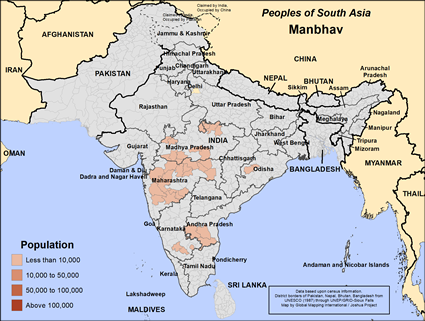Manbhav in India

Send Joshua Project a photo
of this people group. |

Map Source:
People Group data: Omid. Map geography: UNESCO / GMI. Map Design: Joshua Project
|
| People Name: | Manbhav |
| Country: | India |
| 10/40 Window: | Yes |
| Population: | 27,000 |
| World Population: | 27,000 |
| Primary Language: | Marathi |
| Primary Religion: | Hinduism |
| Christian Adherents: | 0.00 % |
| Evangelicals: | 0.00 % |
| Scripture: | Complete Bible |
| Ministry Resources: | Yes |
| Jesus Film: | Yes |
| Audio Recordings: | Yes |
| People Cluster: | South Asia Hindu - other |
| Affinity Bloc: | South Asian Peoples |
| Progress Level: |
|
Introduction / History
The Hindu Manbhav people reside in central India, primarily in the states of Madhya Pradesh and Maharashtra. Historically, they have worked as agricultural laborers and small-scale traders, with strong ties to the rural economy. Over time, the Manbhav have adapted to changing economic conditions, though many still rely on traditional farming practices and local commerce. Some families have moved to nearby towns in search of better employment opportunities, while others remain engaged in agriculture.
What Are Their Lives Like?
The Manbhav people depend largely on agriculture, growing crops such as wheat, rice and millet. Their livelihood revolves around seasonal farming cycles, with entire families participating in planting, harvesting and tending to livestock. Those who live in more urbanized areas have diversified their income through small businesses or work as laborers in local industries.
Most Manbhav families live in rural villages, where they build homes from locally available materials like mud, brick and thatch. Life in these villages centers around family, farming and religious practices. Although some younger members of the community seek education and job opportunities in cities, the majority continue to work in agriculture, maintaining close ties to their land.
What Are Their Beliefs?
The Manbhav people practice Hinduism and observe traditional religious festivals and rituals. They worship deities like Vishnu, Shiva and Durga while also venerating local gods and goddesses connected to agriculture and nature. Religious festivals, such as Diwali, Holi and Navratri, are key moments for the community, bringing families together to celebrate and offer prayers for prosperity and protection.
Temples and shrines are important gathering points for the Manbhav people, where they participate in worship and community activities. Their religious practices often reflect the agricultural cycles, with special rituals performed to ensure good harvests and the well-being of their livestock.
What Are Their Needs?
The Manbhav people face several challenges, particularly in terms of access to education, healthcare and economic development. Many still rely on traditional farming methods, making them vulnerable to changes in weather and environmental conditions. Access to modern agricultural tools, irrigation systems and sustainable farming practices would help improve crop yields and provide greater economic stability.
Education is another significant need, as many Manbhav children have limited access to quality schooling. This restricts their opportunities for social mobility and better employment. Expanding educational opportunities and improving school infrastructure would benefit the community.
Healthcare services are often inadequate, with families having to travel long distances for medical care. Developing better healthcare infrastructure and ensuring access to essential services would address critical needs in the community.
Prayer Points
Pray that the Lord would send dedicated laborers to the Manbhav people.
Pray that the Holy Spirit would open their spiritual eyes so they can see Jesus.
Pray that the Lord would awaken spiritual hunger in them to seek the truth, leading them to Jesus himself.
Pray that an awakening in the people will be contagious and the entire community would find Christ together.